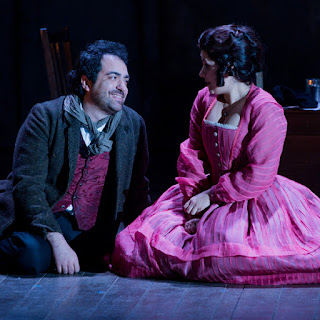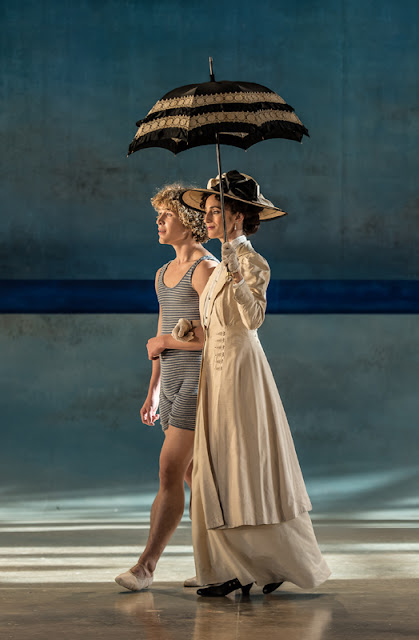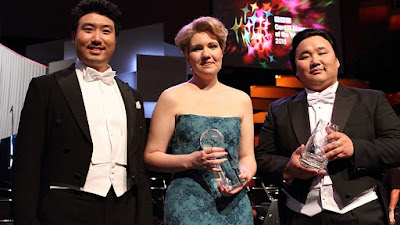Part 2 of my interview with cellist, baritone and re:naissance man Matthew Sharp
 |
| Matthew Sharp |
Continued from Part 1: Talking to Matthew Sharp, I become aware of how interconnected his thinking always it. He constantly refers to other art-forms and seems to be least interested in classical music for its own sake, it is communication which counts. He is also clearly highly literate, and quotes from Shakespeare pop up in conversation in the most natural way possible. He is a profoundly engaging speaker, and I can see how this transfers to his performances with audiences.
And it is not just the performance that concerns him, but the whole concert hall package. He refers to a video on YouTube,
genre hopping with Chris Thile, where Thile talks about attending a performance of Mahler's
Ninth Symphony and feeling such a visceral thrill he wanted to should 'YES' but was told to pipe down. Matthew has great sympathy, and wants the performance to be about that visceral thrill, not the need to sit quietly. He talks of creating domains where people can have a fabulous night out with amazing music, so that they are free flowing without traditional etiquette.
In 1888, Brahms, Tchaikovsky and Greig all met at a lunch
As a performer who is clearly 'of the moment', I was curious about Matthew's attitude to recording, especially as he has so many planned. But he is happy to work with the genre and finds satisfaction in doing something again and again until it is right, but it also has to feel vital and real. He has so far been rather put off recording significant works from the canon as he expresses a dissatisfaction with the genre. He is in discussions about doing recordings of major works, and for these they will bring more of a context to the disc including spoken word and something of what Matthew calls '
a reflection back from the era'. His intention is that works will not be abstracted, but will come from '
an expressed embodied world'. He talks about doing something around the Brahms cello sonatas and is fascinated by the fact that in 1888, Brahms, Tchaikovsky and Grieg all met at a lunch, and all composed significant works for cello within five years of that date. Diary entries from Tchaikovsky and from Anna Brodsky (hostess of the lunch party) also record the event, so he can combine the performances with reportage and songs by the composers too.
Tommy Foggo, superhero
 |
| Tommy Foggo |
Another major project coming up is his new 'interactive musical adventure for 7 to 14-year-olds'. This is entitled
Tommy Foggo, superhero and will involve just Matthew and his cello, singing, playing and storytelling. There will be audience participation, with audience members involved in the action, and group music making. Again, we return to Matthew's concept of a porous relationship between performer and audience. It concerns a young boy, Tommy Foggo, who is left behind by his mother and who gains a sentient cello. This work returns to Matthew's concern with the way we address children in the classical music world, and he sees it as important that they listen as children and not as adults.
The work will be going on a UK tour in the Autumn, visiting schools and children's theatres. The piece is being developed by Matthew with music by composer Steven Deazley and words by Martin Riley. They are the same team with whom Matthew worked on his previous show,
Death's Cabaret - a love story, a cabaret concerto. The idea for this was born of long years of dragging friends along to formal concerts with them saying that they don't know enough about classical music to have an opinion. For Matthew this is something rather bizarre about the relationship in classical music between the audiences and the work. If they went to an art show, most people would have an opinion so he wanted to 'prod the audience into reacting'. He called it a cabaret because you can do al sorts and that a soloist in a concerto is a little like the MC in a cabaret. He performed it with a string quartet, or with an orchestra. The work is about love and loss, and Matthew felt that if the performance was of top quality, then the audience hardly noticed the music as they were moved by the material. He has just given the work's US premiere. For Matthew, the children's shows are part of a continuum which he feels is important for an artist;
'As performers, if you engage with different audiences you see the possibilities of the art form, and refresh your child-like spirit especially for knackered musicians charging round the world.'
In Greek, melos means both limb and melody
 |
| Matthew Sharp |
Other plans include a new concerto with the London Contemporary Orchestra and Stopgap Dance Company. Entitled Incantatio, it features music by the Swiss-French composer Richard Dubugnon. Having done some R&D, they are currently in the planning stages for 2016. This work brings in another of Matthew's interests, the combination of music and gesture. Matthew asks me if I know what melos means; in Greek the word means both limb and melody. Matthew is interesting in the way the two combine; he points out that people listen by watching each other's bodies, and that 55% of communication is through body language. He explains that when telling a story, you need both intention and inflection controlling the ebb and flow of speed and meaning, and for Matthew it is the same in music. If you are clear about your intention, then inflection comes as long as you ensure your gestures are free enough. As with much else that Matthew does, the issue returns back to one of communication, ensuring that the performer communicates as strongly as possible with the audience, and Matthew talks about this combination of securely rooted sound and gesture as visceral.
Our conversation managed to encompass many, but not all, facets of Matthew Sharp's interests, ranging from singing and cello playing, to directing and informing music through gesture, not to mention working with children. What became clear was that each of these is not a discreet area, all blend into each other and clearly inform each other in Matthew's creative imagination. The result is a performer who sees far fewer boundaries than some, and for whom the issue of mutual communication with the audience is paramount.
Elsewhere on this blog:









































%20as%20Leporello%20and%20Erik%20Tofte%20(back%20to%20camera%20in%20garnet%20shirt)%20as%20Giovanni%20-%20Don%20Giovanni.jpg)


